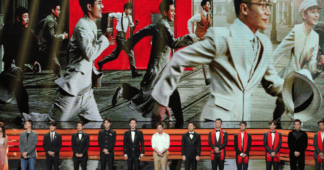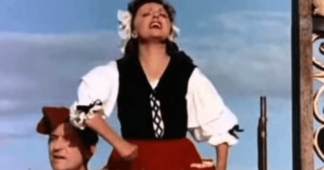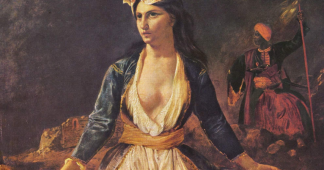By Alan Woods
Wolfgang Amadeus Mozart is considered by many as the greatest musician of all time. He was revolutionary in more senses than one. One of his main achievements was in the field of opera. Before Mozart, opera was seen as an art form exclusively for the upper classes. This was true not only of those who went to see it, but also of its dramatis personae – the characters who were shown on the stage, and especially the protagonists. With The Marriage of Figaro (Le Nozze di Figaro in its original Italian title), all this changes. This is the story of a servant who stands up to his boss and outwits his master.
The very starting-point of this opera was subversive. Beaumarchais’ play, which depicted the aristocracy as degenerate, lustful and depraved types, was considered dangerously revolutionary at the time. In one speech his central character, the servant Figaro, dares to state that he is as good as his master. In the years before the French Revolution, this was subversive stuff! So dangerous was it considered that Louis XVI at first tried to have the play banned. Eventually it was put on stage, and its first performance in Paris caused a riot in which three people were trampled to death. This little incident is a clear indication of the ferment that was building up in French society at the time. Just five years later, the Bastille was stormed. Many of those wealthy patrons of the arts who were present at the first performance of Beaumarchais’ play, and who laughed or booed according to their artistic or political preferences, ended up on the guillotine. Such is the historical destiny of a play which Napoleon later described as “the Revolution in action”.
Of course, there is always the danger of reading too much into works written in the years leading up to the French Revolution or any similar event. But the implications are surely too clear to be the product of mere accident. A great artist, even when he or she has little understanding of politics, is sometimes capable of sensing a certain mood that is developing in society, and to give it a most profound and truthful expression even before it is consciously expressed by the protagonists of the historical process. For his part, Mozart was no revolutionary in the political sense. But he was the child of his times, a product of the Enlightenment who was able to reflect perfectly in his art the general climate of the age in which he lived. He was caught up with the spirit of rebelliousness which was perfectly adapted to his own temperament. This in turn was no accident but flowed from his personal experience of life which left him with a profound hatred of injustice and a sympathy for the underdog, fighting for his rights, freedom, or simple human dignity.
Living in Vienna at the end of the 18th century, Mozart was well aware of the nature of feudalism and the character of the ruling aristocracy. He could scarcely be unaware of the revolutionary message of Beaumarchais’ play, which had been banned by Josef II, the cousin of Marie Antoinette. Josef was considered a relatively progressive monarch for the times (in the style of Friedrich the Great of Prussia and Catherine the Great of Russia). He abolished serfdom in his lands, introduced the right to (relatively) free speech, and even attempted to abolish the privileges of the nobility. It was not unusual to see aristocrats sweeping the streets of Vienna as a punishment for some minor transgression. He also interfered in even the most trivial aspects of life, as when he passed a law forbidding women to wear corsets on public occasions.
Mozart had attempted to democratise opera by writing not in Italian but in the German language (Die Entfürung aus dem Serail). But the influence of Italian proved to be so great (Italian comic opera was then much in vogue) that he decided to write his new opera in Italian (the language of the original was, of course, French). Beaumarchais’ other masterpiece, The Barber of Seville, had already been turned into an (Italian) opera, and was all the rage. Mozart decided to follow suit, with a play which might have been called “Figaro strikes back”.
Mozart’s choice of librettist was an unusual one: Lorenzo da Ponte was a Jew, a freethinker and a libertine, a friend of Casanova. But he was not an experienced librettist. Yet he finished a remarkable libretto in just six weeks. Da Ponte not only succeeded in retaining the full political force of the original, but arguably makes the characters even richer. The spirit of the work is conveyed from the first bars of the overture – a work bubbling over with life and energy. The mercurial changes in the thoughts and feelings of the characters are conveyed with great accuracy by the music. In a novel device, we are plunged straight into the action in the opening scene. Here for the first time we are ushered into the presence, not of gods or goddesses, or classical heroes, nymphs and shepherds, but of ordinary men and women: domestic servants. We enter their quarters and see how they live, how they think and feel. It was the first time that such things were shown on stage.
In this first scene, Figaro is measuring for a bed. This already introduces the central theme, since the bed under consideration is Figaro’s marriage bed. The theme is sex. The significance is that the Count intends to exercise the feudal droit de seigneur: the right of the first night. And Figaro is determined to stop him. Here the right of the master clashes directly with the right of the servant. It is a conflict of wills in which the servant eventually wins. What is being challenged here is the arbitrary power of the feudal aristocracy. Figaro challenges the Count in the famous aria “Se vuol ballare, Signor Contino,” in the first act, which can be translated roughly:
“If you want to dance, my dear little Count,
It is I who will call the tune,
If you’ll come to my school,
I’ll teach you how to caper!”
The aria is apparently cast in the form of an 18th century courtly dance – the minuet. But the essence of the music is very different from the usual minuet. It is an aggressive statement, full of menace and defiance. It is a declaration of war of the servant against his master. In this contest, there can be no doubt where Mozart’s own sympathies lie. This was a feudal society, dominated by rank upon rank of nobles, ranging from the great lords of the land to the petty local landowner, and all of them exercising their tyranny over the mass of the people, not just the peasants who tilled their lands. These nobles behaved like a race apart.
Mozart himself came from the respectable middle class. Yet he was also just another underling to his aristocratic paymasters: a superior kind of servant, but a servant nonetheless. When he served the Archbishop of Salzburg, Mozart was expected to eat below stairs with the servants. His place was clearly specified – above the cooks but below the Archbishop’s valets. When he decided to move to Vienna and leave the Archbishop’s service, Count Arco, one of the Archbishop’s hangers-on and supposedly a friend of Mozart, demonstrated his loyalty to his chief by giving the composer a kick in the buttocks. This incident shows very graphically the relation between the artist and the rich people who bought their services, just as one might purchase an expensive hunting dog. After all, even an expensive dog must be given a kick if it does not do as the owner wishes. Thus, the idea of the servant Figaro getting the upper hand over his master must have greatly appealed to Mozart.
At Vienna Mozart gained fame and popularity. At the high point of his career he attained a certain degree of comfort and prestige. But the threat of poverty and debt was never far away. Mozart needed Figaro to be a success, and was lucky that Josef agreed to allow it. Mozart and da Ponte were both outsiders to the court opera clique, so admirably portrayed in Peter Schaeffer’s play Amadeus. The petty bureaucrats and court mediocrities did their best to sabotage the opera, but it eventually reached the stage in May 1776. There was probably an element of political calculation in Josef’s actions in permitting Mozart’s opera to be staged. At the time he was in conflict with the nobility over the payment of taxes and other matters, and it suited his purposes to show the aristocracy in a bad light. In the end, it was so well received by the Viennese public that by the third performance the Emperor had to order a limit on the number of encores. However, only nine performances were staged. Clearly, the powers-that-be realised the subversive inner meaning of the work.
Figaro is a comedy, but with a serious message. Here is high comedy and low farce, but also moments of great beauty and pathos, as in the countess’ aria at the start of Act 2, “Porgi d’amore..” where she laments the loss of her husband’s love. The Count himself is portrayed as a tyrant, although on this occasion he is not able to exercise his tyranny. This is both a social and a personal tyranny, expressed by the tyranny of the Count over women. The reason why the Count’s tyranny fails him, the opera implies, is because it is seen to be so arbitrary: it is not founded upon Reason, and therefore has no reason to exist, as Hegel would have said. But the same argument could be used against the Ancien Régime in its entirety. A social regime that has outlived itself, is in conflict with itself, has no reason to exist and must be brought down. That was the argument of philosophers like Hegel, and the underlying logic and justification of the French revolution. It is also ever-present in the pages of The Marriage of Figaro.
As we know, there are several ways of fighting against tyrants. One way – as shown in 1789-93 – was to cut off their heads. But, where such drastic remedies are not available, it is possible to use the weapon of ridicule, which is what Beaumarchais and Mozart did to great effect. At the end, the servants are allowed into the drawing-room and dance at Figaro’s wedding. Here the mood changes. The masses appear as triumphant protagonists – not grey figures lurking in the background, but real live individuals with minds and characters and feelings and aspirations of their own. The sight of these men and women dancing in triumph in the aristocrat’s drawing room is pregnant with historical significance. It is both an allegory and an anticipation in music of events that became reality only three years later.
The Marriage of Figaro, with its catchy tunes, good humour and controversial subject matter was a great success. Nowadays, when it is customary to regard opera as art for the elite, it is difficult to realise just how popular these works were. They were the pop music of the day. Those who could not afford to go to the opera could have access to them through arrangements for wind band. Six months after its first performance in Vienna, in December 1787, it was performed in Prague, where it was an even greater success. Mozart was urged to come and see for himself how this music was all the rage – not just in the opera house but as dance music in the ballrooms. He wrote delightedly to a friend: “Here they talk of nothing but Figaro. Nothing is played, sung or whistled but Figaro. No opera is drawing like Figaro. Nothing, nothing but Figaro.”
Mozart’s other operatic masterpiece Don Giovanni, the librettist of which was also Da Ponte, is based on the Spanish theme of Don Juan, which, in various forms, had appeared in literature many times since it first appeared as El Burlador de Sevilla by Tirso de Molina, in 1630. Here the same subject matter that we found in Figaro is dealt with in far more sombre colours, and in greater depth and complexity. The dark colours of this work are evident from the first portentious and threatening bars of the overture. Don Giovanni, like the Count, is a rake, but he is much more than this: he is also a rebel who rejects all social and moral norms. There is an element of anarchy running through this opera, an intuition of the crumbling of the existing social and moral order. Significantly the very first aria of Act One is sung by Leporello, Don Giovanni’s manservant, who curses his lot while waiting in the cold while his master chases after a lady indoors. The message of Leporello’s aria is politically subversive – a call for the social order to be inverted:
“Notte e giorno faticar,
Per chi nulla sa gradir,
Piove e vento sopportar,
Mangiar male e mai dormir,
Voglio far il gentiluomo
E non voglio piu’ servir.
Oh che caro galantuomo!
Voi star dentro colla bella,
Ed io far la sentinella!”
[Night and day I slave
For one who does not appreciate it.
I put up with wind and rain,
Eat badly, never sleep,
I want to be a gentleman
And give up my servitude.
Oh what a fine gentleman!
You stay inside with your lady
And I play the sentinel!]
Leporello, the archetypal comic servant, is thus given a serious theme. His criticism of the dissolute lifestyle of his master (and, by implication, of the aristocracy in general) is continued in the famous “catalogue aria” where he ironically lists Don Giovanni’s amorous conquests. The role of Leporello, the voice of the common people, has been likened to Shakespeare’s combination of low-life comedy and aristocratic high drama, as in, for example, Henry IV, Part One. This role is not at all secondary but pivotal to the opera. In the end, Leporello outlives his master, who is finally conveyed to the flames of hell with the aid of a mysterious Stone Guest.
Having brought Don Giovanni to ultimate justice and consigned him to eternal damnation, Mozart and Da Ponte clear away the sulphur fumes with a brisk and jocular sextet, wherein the survivors point out the moral and ponder their own futures, when the irrepressible Leporello concludes: “Ed io vado all’osteria a trovar padron miglior.” (“And I’ll go to the tavern to find a better master.”) In the 19th century, with its Victorian hypocritical prudery, the cheerful optimism of this final sextet was considered in bad taste, and often omitted. But an irrepressible spirit of cheerfulness always characterises the outlook of the masses, even in the most serious struggles, and Mozart showed an unerring sense of human nature when he finished on this note.
Act One opens with Leporello, the servant, proposing, in effect, that the world be placed upside down. At the end of the same act, Don Giovanni himself proposes an elaborate toast to freedom, which accurately conveys the spirit of the times. The character of Don Giovanni himself is complex and contradictory. His is a far more interesting figure than the Count in Figaro. An adventurer, a dissolute rake, an aristocrat, accustomed to manipulate people according to his own whims, he is at the same time personally courageous. At the end of Act One, when all the world rises up against him, he replies defiantly:
“E’ un orribile tempesta
Minacciando, o Dio, mi va.
Ma non manca in me coraggio,
Non mi perdo o mi confondo.
Se cadesse ancora il mondo,
Nulla mai temer mi fa.”
[A dreadful storm, oh Lord,
Is thundering above me.
But I do not lack courage.
I am not lost or worried.
If the world itself should end,
Nothing could make me afraid.]
At the end, he is prepared to fight against his destiny and against death itself. There were not a few individuals among the aristocracy of this type. Some of them – reactionary adventurers – fought for the Old Regime and went cheerfully to the guillotine. Others, less numerous and more thoughtful, broke with their class and went over to the side of the Revolution, where they fought and died equally bravely. Don Giovanni, had he lived to experience the French revolution, would have ended up as one of these two types.
In one respect The Marriage of Figaro takes leave of both history and real life – but only relatively so. In the finale in Act Four, the Count and Countess are reconciled, as the Count repents his sins. Then all are reconciled and sing in harmony, and so the work ends happily. But it is the essence of all comedy to end happily, or else it would not be comedy. And everyone knows that such endings have little to do with real life. We know that the temporary reconciliation between antagonistic classes cannot last, just as we know that the Count will continue to chase after servant girls at the earliest opportunity.
Every struggle has its moments of temporary respite, just as every war is interrupted by temporary cease-fires. At the start of the French Revolution – as at the start of every revolution – there was a general feeling of euphoria, a fraternisation of all classes in which the king and queen wore the red brocade of revolution. The illusion of universal brotherhood, transcending all class differences for a brief moment possessed the minds of the whole of society. But like all dreams, it was dissolved in the cold light of day. The French revolution began where Figaro left off, but it did not halt there. The further unfolding of the dramatic events of 1798-93 left all illusions behind, as the old world came tumbling down, and the accumulated rubbish of centuries was swept into the dustbin of history.
The road to revolution was prepared by attempts at reform. This phenomenon is frequently repeated in the history of revolutions and has been well documented by Alexis de Toqueville in his famous work The Ancien Régime and the French Revolution. Josef II, Mozart’s patron, attempted such a reform from the top to prevent revolution from below. Like all such attempts, it was doomed to failure. On Josef’s tomb there is a pathetic inscription composed by the emperor himself: “Here lies the prince whose intentions were good, but who had the misfortune to see all his plans collapse.” Mozart died in 1791, apparently as the result of an epidemic, and was buried, according to one of Josef’s numerous petty edicts, outside the city walls in an unmarked grave, which nobody has been able to identify. But the name of Mozart is remembered and revered by millions, while those of his aristocratic overlords are long forgotten.
Published at www.marxist.com
We remind our readers that publication of articles on our site does not mean that we agree with what is written. Our policy is to publish anything which we consider of interest, so as to assist our readers in forming their opinions. Sometimes we even publish articles with which we totally disagree, since we believe it is important for our readers to be informed on as wide a spectrum of views as possible.











